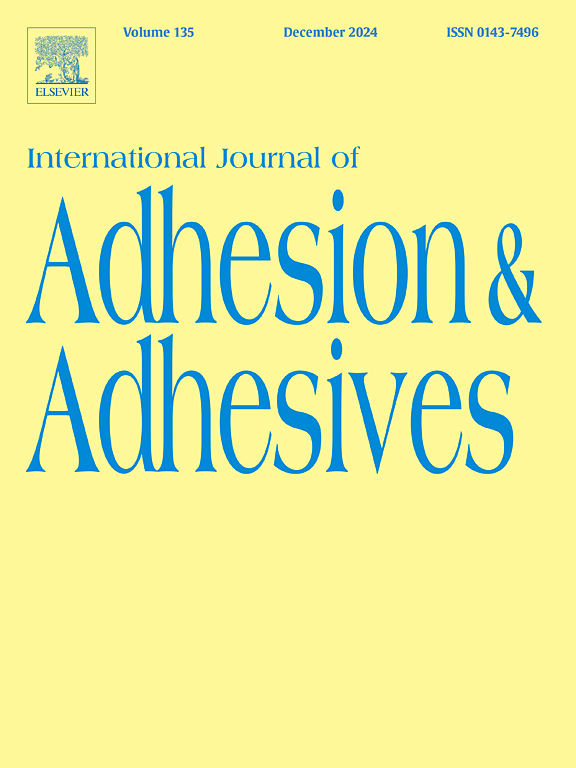Numerical and experimental analysis of Al/GFRP joint for optimization of adhesive bonding strength using response surface method by considering surface patterning of the joints
IF 3.2
3区 材料科学
Q2 ENGINEERING, CHEMICAL
International Journal of Adhesion and Adhesives
Pub Date : 2024-11-07
DOI:10.1016/j.ijadhadh.2024.103877
引用次数: 0
Abstract
Nowadays, adhesive bonding of metals and composites is widely used in the aerospace, automotive and military industries. In the present research, the finite element analysis (FEA) and response surface method (RSM) are used to optimize adhesive bonding strength between aluminum (Al) and glass fiber reinforced polymer (GFRP). For this purpose, the influence of the parameters of joint type, groove shape, groove number, and groove angle was investigated on the bonding strength. The joint type includes Al/Al, Al/GFRP and GFRP/GFRP, the groove shape includes V-shape, square and concave, the groove number includes 1, 3 and 5 grooves, and the groove angle includes 0, 45 and 90°. In order to model the crack growth in the simulation of adhesive bonding, the cohesive zone model was applied. Finally, the optimal sample is fabricated to examine its strength in temperature-humidity environmental conditions. The results of simulation and optimization indicated that the bonding strength improved in Al/Al mode with one square groove at 0° groove angle. The stress-strain diagram obtained from the simulation and optimization results was in good agreement with the sample made under optimal conditions. Moreover, the tensile strength of the optimal sample at temperature-humidity conditions was higher than the tensile force of the sample without groove.
使用响应曲面法对铝/玻璃纤维增强塑料(GFRP)接头进行数值和实验分析,通过考虑接头的表面图案优化粘合强度
如今,金属和复合材料的粘合已广泛应用于航空航天、汽车和军事工业。本研究采用有限元分析法(FEA)和响应面法(RSM)来优化铝(Al)与玻璃纤维增强聚合物(GFRP)之间的粘合强度。为此,研究了接头类型、沟槽形状、沟槽数量和沟槽角度等参数对粘接强度的影响。连接类型包括 Al/Al、Al/GFRP 和 GFRP/GFRP,沟槽形状包括 V 形、方形和凹形,沟槽数量包括 1、3 和 5 个,沟槽角度包括 0、45 和 90°。为了在粘合模拟中建立裂纹生长模型,应用了内聚区模型。最后,制作了最佳样品,以检验其在温湿度环境条件下的强度。模拟和优化结果表明,在铝/铝模式下,槽角为 0°、带有一个方形槽的粘合强度有所提高。模拟和优化结果得出的应力应变图与在最佳条件下制作的样品十分吻合。此外,最佳样品在温度-湿度条件下的拉伸强度高于无凹槽样品的拉伸力。
本文章由计算机程序翻译,如有差异,请以英文原文为准。
求助全文
约1分钟内获得全文
求助全文
来源期刊

International Journal of Adhesion and Adhesives
工程技术-材料科学:综合
CiteScore
6.90
自引率
8.80%
发文量
200
审稿时长
8.3 months
期刊介绍:
The International Journal of Adhesion and Adhesives draws together the many aspects of the science and technology of adhesive materials, from fundamental research and development work to industrial applications. Subject areas covered include: interfacial interactions, surface chemistry, methods of testing, accumulation of test data on physical and mechanical properties, environmental effects, new adhesive materials, sealants, design of bonded joints, and manufacturing technology.
 求助内容:
求助内容: 应助结果提醒方式:
应助结果提醒方式:


